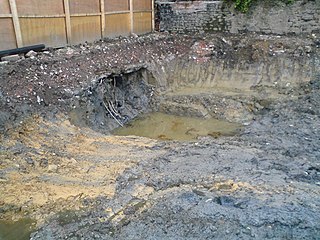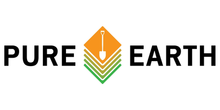
Pollution is the introduction of contaminants into the natural environment that cause adverse change. Pollution can take the form of any substance or energy. Pollutants, the components of pollution, can be either foreign substances/energies or naturally occurring contaminants.

Toxic waste is any unwanted material in all forms that can cause harm. Mostly generated by industry, consumer products like televisions, computers, and phones contain toxic chemicals that can pollute the air and contaminate soil and water. Disposing of such waste is a major public health issue.

Water pollution is the contamination of water bodies, with a negative impact on their uses. It is usually a result of human activities. Water bodies include lakes, rivers, oceans, aquifers, reservoirs and groundwater. Water pollution results when contaminants mix with these water bodies. Contaminants can come from one of four main sources. These are sewage discharges, industrial activities, agricultural activities, and urban runoff including stormwater. Water pollution may affect either surface water or groundwater. This form of pollution can lead to many problems. One is the degradation of aquatic ecosystems. Another is spreading water-borne diseases when people use polluted water for drinking or irrigation. Water pollution also reduces the ecosystem services such as drinking water provided by the water resource.
Itai-itai disease was the name given to the mass cadmium poisoning of Toyama Prefecture, Japan, starting around 1912. The term "itai-itai disease" was coined by locals for the severe pains people with the condition felt in the spine and joints. Cadmium (Cd) poisoning can also cause softening of the bones and kidney failure. Effective treatments involve the use of chelators to promote urinary excretion of Cd. The cadmium was released into rivers by mining companies in the mountains, which were successfully sued for the damage. Remediation efforts in the affected region have been ongoing since 1972 and were mostly complete as of 2012. Monetary costs of the cleanup have been paid for in part by Japan's national government, Mitsui Mining, and the Gifu and Toyama prefectural governments. Itai-itai disease is known as one of the Four Big Pollution Diseases of Japan.

Soil contamination, soil pollution, or land pollution as a part of land degradation is caused by the presence of xenobiotic (human-made) chemicals or other alteration in the natural soil environment. It is typically caused by industrial activity, agricultural chemicals or improper disposal of waste. The most common chemicals involved are petroleum hydrocarbons, polynuclear aromatic hydrocarbons, solvents, pesticides, lead, and other heavy metals. Contamination is correlated with the degree of industrialization and intensity of chemical substance. The concern over soil contamination stems primarily from health risks, from direct contact with the contaminated soil, vapour from the contaminants, or from secondary contamination of water supplies within and underlying the soil. Mapping of contaminated soil sites and the resulting clean ups are time-consuming and expensive tasks, and require expertise in geology, hydrology, chemistry, computer modelling, and GIS in Environmental Contamination, as well as an appreciation of the history of industrial chemistry.

Environmental toxicology is a multidisciplinary field of science concerned with the study of the harmful effects of various chemical, biological and physical agents on living organisms. Ecotoxicology is a subdiscipline of environmental toxicology concerned with studying the harmful effects of toxicants at the population and ecosystem levels.

The health and environmental impact of the coal industry includes issues such as land use, waste management, water and air pollution, caused by the coal mining, processing and the use of its products. In addition to atmospheric pollution, coal burning produces hundreds of millions of tons of solid waste products annually, including fly ash, bottom ash, and flue-gas desulfurization sludge, that contain mercury, uranium, thorium, arsenic, and other heavy metals. Coal is the largest contributor to the human-made increase of carbon dioxide in Earth's atmosphere.

Environmental impact of mining can occur at local, regional, and global scales through direct and indirect mining practices. Mining can cause erosion, sinkholes, loss of biodiversity, or the contamination of soil, groundwater, and surface water by chemicals emitted from mining processes. These processes also affect the atmosphere through carbon emissions which contributes to climate change.
Tianying is a town under the administration of Jieshou, which is in turn administered by the prefecture-level city of Fuyang, in northwestern Anhui Province, China. The town has 26,095 inhabitants according to the 2001 census.

Richard Fuller is an Australian-born, United States-based engineer, entrepreneur, and environmentalist known for his work in pollution remediation.
Tanzania, officially known as the United Republic of Tanzania, is a mid-sized country in southeastern Africa bordering the Indian Ocean. It is home to a population of about 43.1 million people. Since gaining its independence from the United Kingdom in 1961, Tanzania has been continuously developing in terms of its economy and modern industry. However, the country’s economic success has been limited. Environmental obstacles, such as the mismanagement of natural resources and industrial waste, have been contributing factors and results of the relatively low economic status of the country. Tanzania’s annual output still falls below the average world GDP. In 2010, the GDP for Tanzania was US $23.3 billion and the GDP per capita was US $1,515. Comparatively, the GDP for the United States was $15.1 trillion and the GDP per capita was approximately $47,153. Eighty percent of the workers accounting for this annual output in Tanzania work in agriculture, while the remaining 20% work in industry, commerce, and government organizations. Such a heavy reliance on agriculture has placed a huge amount of strain on an already limited supply of viable land.
GAHP is a network of international and national level agencies committed to a collaborative, multi-sectoral approach to address the global pollution crisis and the resulting health and economic impacts. GAHP’s overall goal is to reduce death and illness caused by all forms of toxic pollution, including air, water, soil and chemical wastes especially in low and middle-income countries.

A sacrifice zone or sacrifice area is a geographic area that has been permanently changed by heavy environmental alterations or economic disinvestment, often through locally unwanted land use (LULU). Commentators including Chris Hedges, Joe Sacco, and Steve Lerner have argued that corporate business practices contribute to producing sacrifice zones. A 2022 report by the United Nations highlighted that millions of people globally are in pollution sacrifice zones, particularly in zones used for heavy industry and mining.
Greenaction for Health and Environmental Justice, formed in 1997, is a multiracial grassroots organization based in San Francisco that works with low-income and working class urban, rural, and indigenous communities. It runs campaigns in the United States to build grassroots networks, and advocate for social justice.

Legacy pollution or legacy pollutants are persistent materials in the environment that were created through a polluting industry or process that have polluting effects after the process has finished. Frequently these include persistent organic pollutants, heavy metals or other chemicals residual in the environment long after the industrial or extraction processes that produced them. Often these are chemicals produced by industry and polluted before there was widespread awareness of the toxic effects of the pollutants, and subsequently regulated or banned. Notable legacy pollutants include mercury, PCBs, Dioxins and other chemicals that are widespread health and environmental effects. Sites for legacy pollutants include mining sites, industrial parks, waterways contaminated by industry, and other dump sites.
The Kabwe mine or Broken Hill mine is a former lead smelting and mining site near Kabwe, Zambia, that operated from 1906 to 1994. At its peak, between 1925 and 1974, it was owned by Anglo American plc and was Africa's largest lead producer. The mine produced extremely toxic lead pollution for ninety years. Several studies have confirmed that over 100,000 people near the mine, including tens of thousands of children, suffer from lead poisoning. Kabwe is one of the world's most polluted towns.









